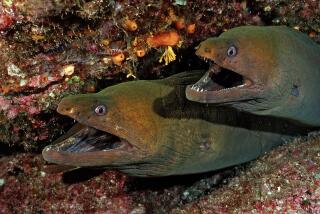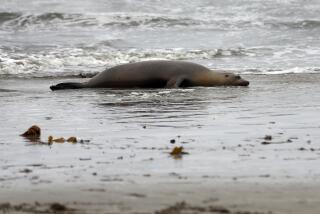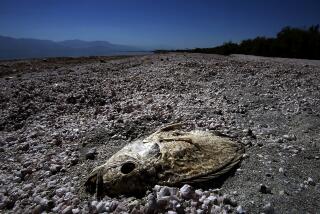Cause Sought for Bird Deaths at Salton Sea
CALIPATRIA, Calif. â Lifeless nests and skeletons covered in feathers are littering the rocky shore of a barren Salton Sea island, confirming the return of the season of death.
âWe normally have some deaths, but when there are full clutches of dead birds, thereâs something wrong,â Ken Sturm, biologist for the Salton Sea National Wildlife Refuge, said Thursday. âObviously something bad happened here.â
Biologists had expected problems this year at Californiaâs largest lake after last summerâs epidemic of avian botulism felled more than 14,000 birds of 69 species, including endangered brown pelicans.
âThere was no change in the ecology of the sea,â said refuge manager Clark Bloom. âWe felt it was just a matter of time before this happened.â
But nobody thought death would return so soon.
By Wednesday, biologists had counted at least 1,700 dead double-crested cormorants that had last been seen alive and nesting on Mullet Island in early March.
The odor of decomposing birds now overpowers the seaâs rotten-egg stench. In 100-degree heat, flies stick to visitors, who must wear rubber boots and remove them before returning to the dock to prevent the spread of disease.
The cormorants are but a small part of the problem. About 2,000 other birds of 38 species have also been found dead on the shore.
An incinerator burns the remains to prevent disease from spreading. A makeshift hospital is being built to stabilize sick birds before they are sent to rehabilitation centers in Inyo and Laguna Niguel.
So far, only four brown pelicans have died. But thousands more are expected to arrive in the next two months from Baja California and the Sea of Cortez, where they spend winter.
Tests to find out what killed the cormorants have not been finished, but some birds showed signs of avian botulism, which targets the birdsâ nervous system and leads to torturous deaths.
Even if avian botulism is determined to be the culprit, it does not explain how the bacteria spread in the artificial seaâs unusual ecosystem or what role the seaâs pollution plays in the deaths.
The salty lake has become a favorite spot for birds on the Pacific Flyway as development elsewhere in California has destroyed natural wetlands. Formed by an accidental break in the Colorado River in the early 1900s, it now covers 380 square miles in Riverside and Imperial counties.
Today, it is fed only by agricultural runoff and polluted water from the New and Alamo rivers. It is now 30% saltier than the Pacific Ocean.
More to Read
Sign up for Essential California
The most important California stories and recommendations in your inbox every morning.
You may occasionally receive promotional content from the Los Angeles Times.










